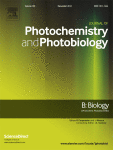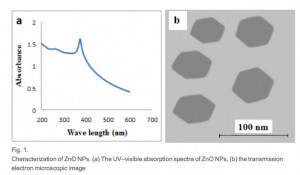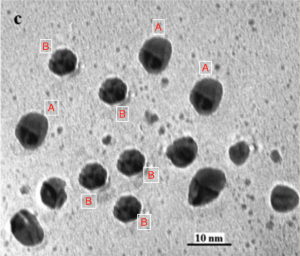 Recently, François-Xavier Coudert, a researcher at the Research Institute of Chemistry of Paris in France, noticed something strange: A nearly perfect image in a chemistry paper, with none of the typically expected “noise.”
Recently, François-Xavier Coudert, a researcher at the Research Institute of Chemistry of Paris in France, noticed something strange: A nearly perfect image in a chemistry paper, with none of the typically expected “noise.”
Last week, he started a thread on PubPeer, alerting readers to his concerns — namely, that a microscopy image showed hexagons with crisp edges. The author responded that the students had been working to obtain a “perfect hexagonal structure,” and had adjusted the contrast of the image to make it seamless. But, the author noted, the paper was being retracted for other reasons.
Indeed, a spokesperson for Elsevier, which publishes the Journal of Photochemistry and Photobiology B: Biology (JPB), has confirmed to us the paper will be retracted. Here’s the upcoming notice for “Influence of humic acid on the stability and bacterial toxicity of zinc oxide nanoparticles in water,” which cites image duplication as the reason:
This article has been retracted at the request of the Editor of Journal of Photochemistry and Photobiology: Biology (JPB), because of the following reasons:
It contains results which were previously published in Colloids and Surfaces B: Biointerfaces 102 (2013) 195 – 201, DOI: 10.1016/j.colsurfb.2012.07.034, namely:
-Fig. 1a (JPB) is the same as Fig. 1a (COLSUB): both the UV-visible spectra are found to be identical but in the latter paper commercial ZnO nanopowder was used and not laboratory synthesized ZnO, so these results are not in line with the expectations.
-Fig. 2 (JPB) is the same as Fig. 2 (COLSUB): both these figures are identical in the concentration range 0-40 mg/L and the authors seem to have removed the data of two traces in the case of the JPB paper.
-Fig 3a (JPB) is the same as Fig 3 (COLSUB): the surface properties of HA and BSA proteins are different and hence the zeta potential values are expected to have different values. However, the authors report similar zeta potential plots with negligible difference for both HA and BSA.
It contains results which are very similar to results previously published paper J. Photochemistry and Photobiology B: Biology 138 (2014), 155-159, DOI: 10.1016/j.jphotobiol.2014.05.013, namely:
-Fig. 1d is the same in both papers. The d-spacing values for both figures are also the same. The explanation given by the authors is not correct.
-Section 2.5 as published in JPB 138 (2014), 155-159 is very similar to Section 2.11 in the retracted paper without giving appropriate reference.
Fig. 1e is the same as Fig. 1f as previously published in J. Photochemistry and Photobiology B: Biology 141 (2014), 235–240, DOI: 10.1016/j.jphotobiol.2014.09.010. However, the previously published paper deals with Ag2S nanoparticles while the retracted paper deals with ZnO nanoparticles. EDX peaks are characteristic of various nanoparticles. The authors have reported the EDX peak of ZnO nanoparticles at 3 KeV which is contrary to the expectations.
The 2015 paper has been cited once, according to Clarivate Analytics’ Web of Science, formerly part of Thomson Reuters.
Here’s the image in question — which isn’t one of the figures cited in the notice as problematic:
An author noted on PubPeer:
For the past few years my students are working continuously in my laboratory to get hexagonal shaped ZnO NPs and we could achieve the same. The results were so perfect and TEM images were taken until we get very low noise and perfect hexagonal structure. The low noise was avoided by adjusting the contrast of the image.
The author added:
But, I would like to inform you that due to some other reason, the manuscript has been withdrawn from the journal and it will be appeared as “manuscript Withdrawn” soon in the journal website. For the confirmation, may be you can contact to the journal editor.
The corresponding author on the paper is S. Sudheer Khan from the SASTRA University in Thanjavur, Tamil Nadu, India — and this isn’t the only paper of Khan’s that Coudert has paused over. Last week, he started another thread about “Synthesis and characterization of silver sulfide nanoparticles for photocatalytic and antimicrobial applications,” also published by the Journal of Photochemistry and Photobiology B: Biology (JPB) and co-authored by Preethy Chandran from the SASTRA University. Coudert flagged some possible duplications; the author responded that they had tried to fix the error with a corrigendum, but the paper was being pulled “due to some other reason.”
The Elsevier spokesperson confirms that the 2014 paper will soon be accompanied by the following retraction notice, which mentions one of the images flagged by Coudert:
This article has been retracted at the request of the Editor of Journal of Photochemistry and Photobiology: Biology (JPB), because:
-Fig. 1C is the magnified version of Fig. 1C as previously published in Spectrochimica Acta Part A: Molecular and Biomolecular Spectroscopy 137 (2015) 503–508, DOI: 10.1016/j.saa.2014.09.004. However, these papers deal with different nanoparticles: Ag2S and Ag respectively.
-The degradation data in Fig. 4 is the extension of the results given in Fig. 4 as previously published in Solar Energy 105 (2014) 542–547, DOI: 10.1016/j.solener.2014.04.028.
Two of the papers mentioned in these retraction notices have also been flagged by Coudert — both of which also now include comments from the authors that they will be fixed by corrigenda.
In one case, last year Coudert flagged an image that contained striking similarity between the nanoparticles:
Yesterday, an author of the 2015 paper in Spectrochimica Acta Part A: Molecular and Biomolecular Spectroscopy — “Highly selective colorimetric detection and estimation of Hg2+ at nano-molar concentration by silver nanoparticles in the presence of glutathione” (cited six times) — said on PubPeer they were submitting a correction:
We have identified the error and corrigendum is under progress. The corrigendum will be appeared in the journal website soon.
Also last week, Coudert raised concerns about a figure in a 2014 paper, “Effect of humic acid on photocatalytic activity of ZnO nanoparticles,” which has garnered cited seven times since being published in JPB. Again, the author responded:
It was an error and corrigendum is submitted for the other one. It will be published soon in the journal website.
Khan and Chandran are listed as authors on all four papers.
We’ll update the post with anything else we learn.
Update 1/16/17 2:06 p.m. eastern: The notices for the two retracted papers have been published:
- Synthesis and characterization of silver sulfide nanoparticles for photocatalytic and antimicrobial applications
- Influence of humic acid on the stability and bacterial toxicity of zinc oxide nanoparticles in water
Like Retraction Watch? Consider making a tax-deductible contribution to support our growth. You can also follow us on Twitter, like us on Facebook, add us to your RSS reader, sign up on our homepage for an email every time there’s a new post, or subscribe to our daily digest. Click here to review our Comments Policy. For a sneak peek at what we’re working on, click here.


It amazes me how none of the editors or peers picked up anything during peer review.
Dr. Chandran is a co-author of the following paper: Preethy Chandran and Nilanjana Das, “Characterization of sophorolipids biosurfactant produced by yeast species grown on diesel oil,” International Journal of Science and Nature 2(1) 2011: 63-71. According to Google Scholar, this paper has been cited 23 times.
Note the journal’s name.
International Journal of Science and Nature
Not to be confused with the Journal of Nature and Science, which in turn should be distinguished from Marsland Press’ “Nature and Science”.
In one case, last year Coudert flagged an image that contained striking similarity between the nanoparticles:
Coudert notes that the editors of Spectrochemica Acta were alerted to the problem in December last year, but
It was an error and corrigendum is submitted for the other one. It will be published soon in the journal website.
I am not entirely sure how a corrigendum submitted for the first version of the image (purportedly showing Ag nanoparticles), that will explain how multiple copies of the same
Hallowe’en masksparticles have cloned themselves across the slide, will also suffice to explain how in the second version the nanoparticles are ZnO.If they really or actually read what was written , or they are from different research background .